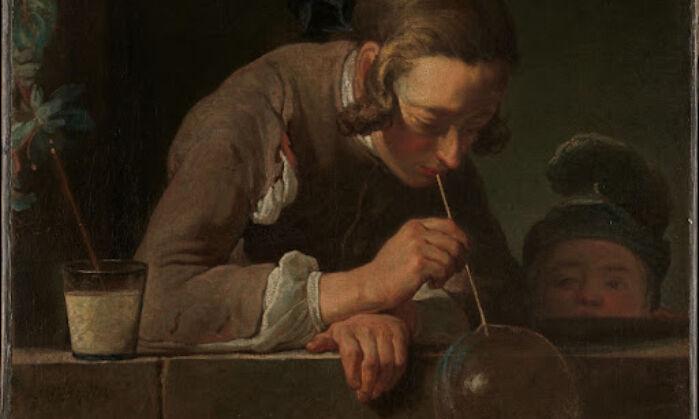Do you remember when you were a child, and you wanted to know about everything?
Children have a sense of wonderment with the world. They approach it with an innocent curiosity, and they question everything with a sincere interest in understanding the things around them.
As we get older, we get stuck in a routine, losing this sense of wonderment. Our routines become monotonous and seem to hypnotize us into complacency. Over time, we lose the purity of our innocent interests for the distractions of self-interest.
Chardin’s ‘Soap Bubbles’
Around 1734, French painter Jean Siméon Chardin created a composition called “Soap Bubbles,” which was one of several paintings depicting the same theme. This painting might give us insight into how we can break through the distractions of our self-interests and regain our sense of wonderment.
The painting is composed in a square format. Two young boys and a plant occupy the space.
If we squint our eyes at the image, almost all of the information disappears except for the pot and the boy in the middle, and this lets us know that these two elements are focal points. The pot sits on the ledge to the left of the composition, and it contains a plant that grows up and out of the left side of the picture plane.
Back in the center of the composition, the boy’s illuminated skin stands out against the harmoniously muted browns and grays surrounding him. He blows a soap bubble as he leans over the edge.
Memento Mori Painting and the Transience of Life
What does Chardin’s painting mean? At first glance, it’s just a boy blowing a bubble. According to The Metropolitan Museum of Art’s website, “soap bubbles were then understood to allude to the transience of life.”If Chardin’s painting has to do with the transience of life, we can associate it with a genre called “memento mori” painting. Memento mori means “remember death.” Paintings in this genre remind and warn their audience that death is the great equalizer and comes for us all. Life is over in the blink of an eye, so we must be sure to cherish our lives; otherwise, we will die with regrets.
How does Chardin’s painting remind us to remember death and to cherish life?
The soap bubble represents our lives and the transience of life. Knowing this, we can imagine the children as teenagers, middle-aged, and elderly. Chardin captured their whole lives at this moment despite their youthful features eternalized by the oil paint.
Though their youthful appearance is eternal, the soap bubble is ephemeral: It can pop anytime. Maybe it won’t pop immediately but will be carried by the wind before it pops. Maybe the little boy behind the ledge will blow it and cause it to pop. Maybe either boy will pop it by trying to catch it with his hands. Or maybe it will pop before it leaves the straw it’s attached to. No matter the scenario, however, the bubble will eventually pop.
Cherishing Life Is the Key
Our self-interest can distract us, but we can’t take anything with us when we die. What we can do, however, is cherish every moment of our lives. We can look in on our lives; we can reflect on our moments with childlike innocence and wonderment, like the little boy in the background looking at the blown bubble.To return to our original question, might it be the case that the picture plane’s boundary represents the distractions caused by our self-interests? To me, this is why the plant is relevant. It’s interesting how the plant leaves the picture plane. The picture plane is the boundary that frames the image, and here the plant breaks through that boundary.
Does the plant represent our lives when we live with wonderment? Does this suggest that a life filled with pure and innocent curiosity is not delimited by usual boundaries? Is recognizing the transience of our lives truly enough to recapture the wonderment we once had for being alive?





